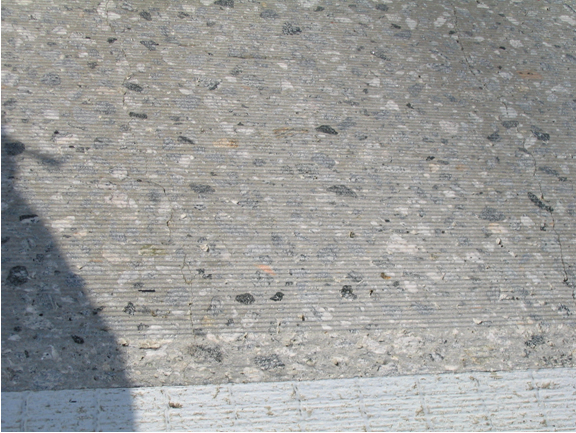Section 9: Diamond Grinding
Anchor: #i10116829.1 Introduction
Diamond grinding (DG) removes a thin layer at the surface of hardened PCC pavement using closely spaced diamond blades. DG used to be an expensive operation; however, new, high-production equipment as well as improved synthetic diamonds for saw blades made DG a more cost competitive option for PCC pavement rehabilitation. DG has not been extensively used by the department as a pavement rehabilitation option. Rather, it has been used primarily for removing bumps in the newly placed concrete pavement, especially at the transverse construction joints, to achieve ride quality specifications. The level surface is achieved by running the blade assembly at a predetermined level across the pavement surface, which produces saw-cut grooves. The uncut concrete between each saw-cut breaks off, more or less, at a constant level above the saw-cut grooves, leaving a level surface with longitudinal texture as shown in Figure 10-28.
Figure 10-28. Close-up view of diamond ground surface.
The advantages of DG as a PCC pavement rehabilitation option include:
- Anchor: #UMJTULLW
- improves pavement smoothness, Anchor: #AAKSAYDB
- costs substantially less than an overlay, Anchor: #VHDNTDFM
- enhances surface friction and safety of an old concrete pavement surface, Anchor: #KQOCUQNT
- significantly reduces noise generated by tire-pavement interaction, Anchor: #JXHQYLWW
- does not affect fatigue life or material durability of the pavement, Anchor: #BRHMOFNL
- can be accomplished during off-peak hours with short lane closures and without encroaching into the adjacent lanes, Anchor: #JXXAHEDN
- eliminates the need for taper, which is required with overlay alternatives, at highway entrances, exits, and at side streets, Anchor: #CFXQIWRC
- does not affect overhead clearances underneath bridges or hydraulic capacities of curbs and gutters on municipal streets.
As can be seen above, DG can be a useful tool primarily to correct functional distress (noise, roughness, and skid resistance) in PCC pavement. DG has been used extensively in other state departments of transportation. For example, Georgia DOT uses DG as a routine rehabilitation option. For the rehabilitation of CPCD where dowel bars were not used, they do not use dowel bar retrofit; rather, they diamond grind their CPCD every few years when the faulting at the joints exceeds a threshold value. Their diamond ground surface rides smooth and quiet.
Anchor: #i10061529.2 Pavement Distresses that Require Diamond Grinding (DG)
As stated above, DG can be a useful tool to correct functional distresses caused by pavement surface defects, such as, noise, roughness, and skid resistance. When noise has become an issue, research data shows that DG can reduce noise level significantly. Pavement roughness increases dynamic loading and resulting wheel loading stresses, thus reducing pavement life. Pavement roughness can be effectively corrected by DG. DG increases macro-texture of the surface, thus improving drainage and skid resistance, and reducing the potential for hydroplaning.
Anchor: #i10061629.3 Other Issues with DG
The depth of DG is normally between 0.1 and 0.25 in. The increase in wheel load stress due to the reduced slab thickness by DG can be more than compensated by the reduction in dynamic loading. Also, the effect of reduction in thickness for thicker slabs is not as much as that for thinner slabs. The department has been building thicker slabs in anticipation of increased wheel load applications. DG will have a negligible effect on structural capacity of rigid pavement.
Deeper diamond grinding will expose the coarse aggregate in the concrete pavement. Softer coarse aggregates that are exposed may polish and result in lower skid numbers.
The department developed special specifications for diamond grinding.
